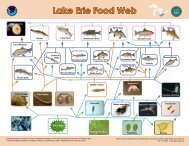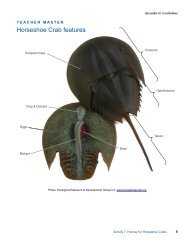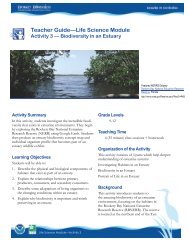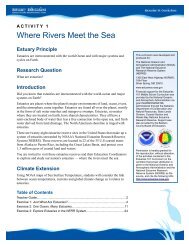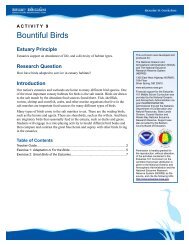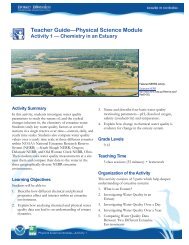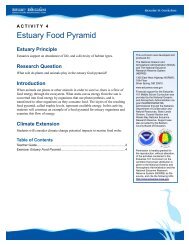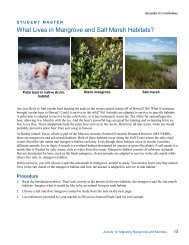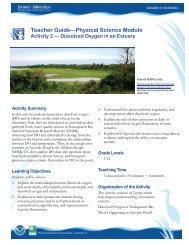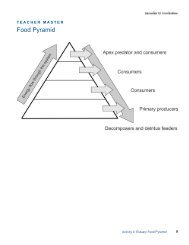Teacher GuideâEarth Science Module - Estuaries NOAA
Teacher GuideâEarth Science Module - Estuaries NOAA
Teacher GuideâEarth Science Module - Estuaries NOAA
You also want an ePaper? Increase the reach of your titles
YUMPU automatically turns print PDFs into web optimized ePapers that Google loves.
Student ReadingActivity 4: Extreme Weather in an EstuaryUsually, when extreme weather occurs, the damagecaused by it is categorized in dollars and lives lost.However, the tremendous damage on animal and plantspecies is rarely addressed. <strong>Estuaries</strong> are places oftransition, a zone of constant change in which physicaland chemical properties of water constantly shift andmove in response to tides, daily cycles, and seasonalvariations. Storm events have the power to alterconditions in an estuary in a dramatic and sometimescatastrophic way that threatens the survival of thousandsof organisms that live there.The focus of this activity is the North CarolinaNational Estuarine Research Reserve (NCNERR).North Carolina’s estuarine system is the third largest inthe country, encompassing more the two million acres.This system is of prime economic importance to thecoastal area—90 percent of the commercial seafoodspecies caught in the state spend at least part of theirlives in an estuary. The North Carolina NERR was establishedto preserve these fragile natural areas and thevariety of life they support.In this activity, you will investigate the features of theNorth Carolina NERR, and then study the effect ofsevere weather on NERRS sites. Then, you will investigatewhat happened to this estuarine area as a hurricaneapproached, struck the coast with 100 mphwinds, and then moved into the Atlantic Ocean.<strong>Estuaries</strong> are in one sense resilient. After a majorstorm, water in estuaries can act as a buffer, absorbinglarge quantities of excess precipitation and floodwaterbrought in by streams and rivers. However, toxinssuch as fertilizers, animal and human wastes, and otherchemical products washed into the estuary during andafter a storm can make water quality such thatnumerous animal and plant species face destruction.After a major storm event, water quality slowly returnsto normal. As sediment settles to the bottom, plantgrowth is renewed, dissolved oxygen rises, and the pHof the water returns to normal levels. The timerequired to return to normalcy is dependent on theamount of toxic materials carried into the estuary bythe floodwaters produced by the storm.Earth <strong>Science</strong> <strong>Module</strong>—Activity 47



